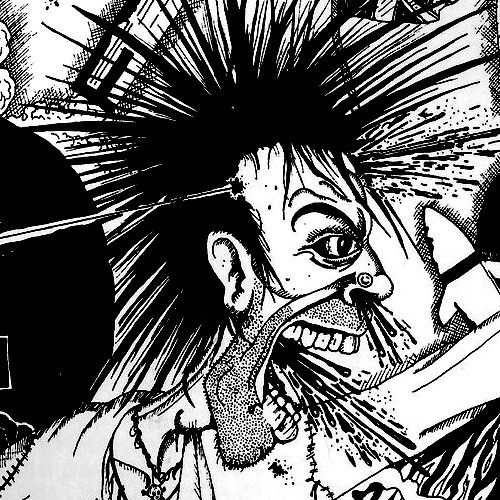Gee, if only there was some way to have seen this coming before hand…
Yup.
Could have put the money in stock instead and they’d likely have made a profit since then.
Hell, they could have stuffed it into their mattress and it would have been a better investment lol.
Inflation can’t even lose this much money is such a short time
The first tweet nft sold for $2.9mil and is now “worth” less than $4.
Like it was worth anything at all in the beginning anyways
Edit: Spleling
Beautiful edit.
Might a a good idea to buy it, I’m sure it will sell for 10$ with some haggling.
- lose
Actually I didn’t have many hopes in humanity when it started to happen. It’s a bit comforting, not much though with other things around.
🌍👨🚀🔫👨🚀
Were they worth anything to begin with?
deleted by creator
No one will convince me that there isn’t money laundering going on there. There’s just no way an actual person looked at that and thought it is worth that kind of money
Yeah, $17M USD. It would be interesting to see the real bidders and their history
Well, no piece of art has an intrinsic value. And auction houses exist to make money, not because of some divine purpose to connect true art to its worthy new owner. Of course they’re going to jump on the hype train if they think it’s worth it. I fully agree that NFTs are a scam, like almost all crypto crap. But so is the current art market. Money laundering and investments for the rich.
It’s crazy how interlinked black market dealings and money laundering have been to the art world. I shudder to think the amount of artists careers that were made because a couple guys needs to pay each other millions of dollars for something worthless to easily make some clean money on illicit exchanges.
I’d love to print out that shitty pixel art and wave it at the person who spent $17M on that garbage… Unfortunately I’m sure it’s someone $17M doesn’t mean much to.
A better question would be, did anyone ever even buy them to begin with?
This means that 79% of all NFT collections – otherwise known as almost 4 out of every 5 – have remained unsold.
That is, most of the NFTs included in the OP statistic were listed for sale by their creators, and never recorded a sale. Another important detail is that even for the ones that did record sales, there’s no real way of knowing if those sales were real. You can easily make another crypto wallet and buy an NFT from yourself. For more elaborate wash trading, you can find someone with an established wallet to collude with. There are obvious reasons to do this too; building up a history of increasing sale prices could potentially dupe someone into thinking an NFT is a good investment, or you could launder money by selling an NFT to a ‘dirty’ wallet you also control.
Probably some portion of the market was “real”, but the volume is almost certainly much lower than anyone is reporting. Statistics like what the OP article is quoting are just about totally meaningless.
I knew people (well one person; in my developer meetup group) that went deep on the NTF craze, like has an spe avatar unironically, spent a bunch on NFTs, and if they’re telling the truth made bank off of them.
It’s pretty disappointing. I wonder whose money they took.
Again, probably some of it is real, and that’s the segment people who made money dealt with. I think of it as a sort of gambling; your acquaintance won a gambling game, someone else lost. Possibly there were some overly wealthy people buying them for status, or maybe that’s just a myth. But the point is, most NFTs themselves aren’t part of that at all, were never a part of any real market, so doing analysis on them is going to be misleading.
Hundreds of millions collectively, when people were dumb enough to buy them. The problem is that eventually dumb people ran out of money and the worth plummeted to zero.
Cost vs worth. Their pricetag may vary; but they’ve been worth nothing since their inception.
Elon musk is worth 250B (source Forbes, idk how legit)
He’s like a piggy bank - gotta break it open to make a withdrawal.
Just because something is unique doesn’t mean it’s valuable.
Some people are just discovering this.
It’s not even that it’s unique. It’s just one particular system associates you with something. It’s basically those star registry scams. Except you’re not associated with a star by one particular scam organization. You associated with an image of a cartoon ape by a scam organization! But there’s a trendy technology involved so idiots think that makes it somehow legit.
6444&'"_@@¶&5tyj7tfsdyoohoof
Behold my one of a kind unique string of characters. Me I own this tangible property. But lo! For only 0.42069lol “BTC-lts33” (a REAL and stable currency that is NOT speculative AT ALL) I will maintain a CSV on my server (
192.168.6.9/wp-admin/test/test2/myPage.php) I will serve you a guaranteed locally unique identifier (starting at “3” (I’m holding on to the other two strings for a rainy day)) that points to the row with this string, so you can show off that YOU are the sole owner of this totally unique investment property.This server is guaranteed up, with 100.00000% uptime since this morning
Try telling that to sports memorabilia collectors though.
“Look at my hockey jersey!” “Yeah, so? I have the same one.” “Yeah but you’re wasn’t signed by Wayne Gretsky.”
Or even trading cards, or comics. Or hell, even plain w-shirts with a brand logo on it for $250. People assign arbitrary values to stuff all the time. I don’t understand it at all, but there’s a whole ton of people that just eat that shit up like it’s candy.
That arises at least somewhat more organically around a real interest that millions of people have been enjoying and obsessing over for generations. So it’s not fair to say it’s totally arbitrary.
The logo stuff is weird though. That’s definitely more “Veblen” like the high price point is itself a flex and desire for, if not true luxury, then the appearance of opulence.
However NFTs were trying to assign value to the receipt for the Gretzky shirt.
Well no, in my example the shirt is the image and the signature on it is the NFT bit. Physically, it’s just a bit of ink, but the shirt itself is no different than one you can go pickup at the store.
In your example what happens if the shirt is sold to someone else? In the NFT case the signature changes.
The shirt analogy doesn’t work well, but NFTs are great for transferable tickets.
Each one of my shits is unique, but just as valuable as an NFT
It can have real value if you use it to fertilize a square meter of dirt and plant corn on it. Shit + water + seeds = food.
They were always worthless
Not to the people targeting the suckers out there…
And they still are!
🔫️ Always have been
If value is completely dependent on speculation how the fuck do people expect to make money?
Crypto Booms: “This is the future of money. You can’t lose.”
Crypto Busts: “I’m just interested in the tech it’s not about money.”That is some high grade cope. Highly refined. 99.99% pure cope.
Those are two different communities that are interested in crypto. Some of the crypto bros used the pro-decentralized peoples logic to cope… but there are both.
I’m surprised there aren’t more of the decentralized endorsers here, amongst a community of technically literate people using FOSS software.
Yeah it’s almost like software-freedom ultranerds don’t buy the claims. Weird. What could it mean, for a technically-literate community with no financial interest to reject the technical claims of people who’ve bought in? Which conclusions might we possibly infer, from people who obsess over the details of decentralized systems, when they treat an allegedly decentralized ledger like pointless garbage? Who among us could theoretically derive elucidating information from the eventuality wherein diehard open-source coders dissent against conservative-adjacent libertarian tech bros vis-a-vis the merits of the latter’s supposedly relevant magic beans? Whence springs any hint of insight, whereupon a community collectively obs
I mined for years, 2011-2014 or so. I don’t need a lecture on crypto culture lol
Greater fools.
Of no surprise to anyone.
NFTs were the perfect technology to identify people who didn’t understand crypto. The only reason Bitcoin et al. even almost work is that nearly anything can be a medium of exchange… so long as it’s fungible. Which is the F theses Ts are N.
But if all you saw was numbers going up, and you don’t know what a Ponzi scheme is, yeah sure it makes total sense to buy a genuine commemorative plate of the Brooklyn Bridge. Why’s everyone on your case? It must be worth money! It’s (a receipt for a link to a picture of) the Brooklyn Bridge!
Fanbros compare stocks, but stocks are slices of a real company. You control one-zillionth of an actual business. If you own enough, that company will do what you say, because you are literally their boss. No amount of “authentic” Brooklyn Bridge tokens will ever mean you get the bridge.
Everything signifying that the exchange was worth your money is a fiction created by the people who took it. That’s how scams work.
Awesomely described - you have a way with words… mindbleach.
The value of tokens on the Blockchain are ostensibly related to the value of the apps that stake/work supports. NFTs were just another attempt at creating some real app/service value which didn’t have all the difficulty or intrinsic value problems that being a payment processor does.
The core problem is the same though. Speculative value of the tokens can’t really exceed the actual intrinsic value of the underlying Blockchain apps. For such apps to actually work as intended, more thought needs to go into anti-speculation mechanisms.
NFTs were a drunken hackathon project that got wildly out of hand. They don’t even do the one thing they intended - storing tiny images. They had to settle for links.
Payment processing has literally nothing to do with NFTs.
Y’know how Inglorious Basterds spends ages humanizing individual Nazi soldiers? You get whole-ass backstories for some of them. Meanwhile the allied hit squad and resistance saboteurs are brutal, merciless, dishonest, petty, and sometimes just plain dumb. It’s like making a whole movie about the casual war crimes at the beginning of Saving Private Ryan. By giving audiences every possible opportunity to empathize with these enemy forces, Tarantino was asking if there was any point where they’d feel bad about about killing Nazis, and the answer is a pretty resounding “no.”
NFTs are like that for scams. Every possible excuse for taking them seriously has been stripped away, and some people simply do not care. You don’t get anything. You don’t really control it. It has no intrinsic function, purpose, or value, beyond what you already had before paying for it. It’s a receipt for a link to a thing that does not matter in the first place. But you slap words like “genuine” and “decentralized” on there, and it breaks people’s brains.
There really is an “official” NFT of the Brooklyn Bridge. Which means nothing. There’s no relation. It’s technically not the classic bridge-selling scam inasmuch as nobody’s selling you the bridge, but they are absolutely taking your money in exchange for fuck-all.
But it was nice while artists were able to sell to profit from rich people
Was that happening? All I ever heard about was people selling artists art that they didn’t own the rights to without permission, and getting away with it
God I am not going to miss every art community being flooded with low effort developer art that had no actual artistic merit.
I mean I do developer art, but I wouldn’t try to sell it, let alone sell it as an investment. Fucking rofl
Yes, many artists made a lot of money on NFTs
If you are referring to scam artists, you are 100% right! Also, some actual artists might have got some money out of it, but I suspect the majority of dough that exchanged hands went to the former kind.
I’m sorry you dont have any technically inclined artists in your circle, but I first learned about NFTs from myartists friends.
Colored coins have been around for a very long time, and NFTs have been an income stream for artists long before the financial elite gave them a bad name.
History is important
The major nft exchanges paid a portion of each sale to the artists, yes. It was one of the things that NFTs, and blockchain in general, was supposed to help solve for. IMO it’s a good use case for blockchain being used when paired with real world items.
But we don’t need blockchain to do any of that, someone still has to be trusted so might as well just use normal database tech.
Don’t need blockchain, no, but blockchain has some advantages since its peer verified and, when implemented well, much harder to fake data than a centralized database might be.
With a normal database we have to trust the one person/entity managing it.
With blockchain, it’s a community that we trust.
Ok, ok, hold on - what’s being sold here? A link to a digital asset or something else? If it’s a link, I still don’t get the point. Does that link (or whatever it is) confer some kind of license? What’s the use case for faking this data and why are we defending from this?
My idea is that the art is being sold and the NFT only says who owns it. It doesn’t need to be digital art, it can be just about anything where an original creator should benefit from the item changing hands.
Whenever the NFT changes hands, there are fees associated, which would include a portion of the sale going to the original artist, a royalty. And because the NFT exists on a publicly visible blockchain, back alley sales can’t happen ensuring that the artist gets paid.
This type of thing helps ensure that artists benefit from their art going into demand and increasing in value.
Blockchain mathematically guarantees trust… for info stored on the blockchain. What guarantee do you have that this info matches things that happen in reality?
If you say: we need a social contract to ensure people update the blockchain, then I say: that defeats the purpose of the heavy lifting you need to mathematically guarantee info on the blockchain is genuine. Let’s just have a social contact to pay the artist when appropriate.
I don’t see what other way could exist to keep the blockchain and reality in sync.
The actual artist? The one that created the art? Not the one that stole the artist’s work and turned it into an NFT for a quick buck from something they had no right to?
Yes. The actual artist.
That was one of the things that was working quite well during the NFT hype.
Pumped, dumped, done.
To be real, even cryptobros would tell you the vast majority were useless as soon as they were minted.
It’s why they pushed them so hard. They hoped we were stupid enough to buy into it and make them richer.
Perhaps they’d have retained value if they had been attached to quality art rather than awful-looking algorithmically generated complete trash.
No, they wouldn’t have. Because owning a link to a thing doesn’t mean anything, no matter what that thing is. They were only valuable because people didn’t understand NFTs and wanted to get rich quick.
The concept of a certificate of authenticity for digital goods that can be traded isn’t inherently terrible.
The concept isn’t, I agree. But it also isn’t a useful idea, either. There really doesn’t appear to be any benefit to using NFTs in any meaningful application, or at least nobody has pitched one that isn’t either a grift or a way to appear “trendy” by reinventing the wheel.
The actual infrastructure was horribly inefficient, but that may have improved with ETH’s move to proof of stake.
There’s other issues, but the idea of using the digital receipt as an “investment” seems fundamentally flawed.
Some established, legitimate artists have been selling NFTs with their originals. But sure, overall, like crypto in general, the field is filled with scammers and get-rich-quick schemes.
I know someone who is a painter who for some reason decided to try selling NFTs a couple of months ago (I pointed out it was a bit late…). The only responses on opensea and Instagram she received were from scammers, trying to pull a “my payment didn’t work, you need to manually approve it” scheme to try to steal her credentials.She could also simply write down the name of the person who bought the painting from you. And ask them to let her know if they sell it so she could update her records.
Sure it’s possible someone might not let her know they sold the painting. But it’s equally possible someone sells the painting without transferring the NFT along with it.
Sure, and instead of credit cards, the store can just write down on an index card that I owe them $60. Anyway, the idea is a level of automation exceeding what they had in Sumeria 7,000 years ago.
Wait. They were actually worth something!?





















